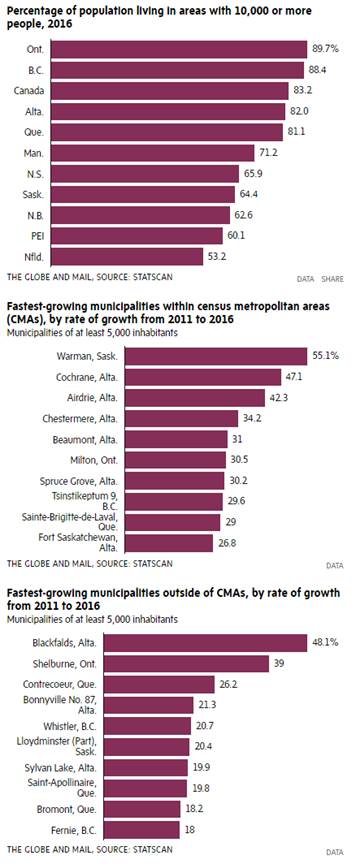
Big Canadian cities see faster suburban growth despite bid to boost density
TheGlobeAndMail.com
Feb. 08, 2017
Bill Curry
Canada’s largest cities are expanding fastest on the fringes in spite of government efforts to contain growth and encourage density.
The first wave of results from Statistics Canada’s 2016 census shows the country’s urbanization trend continues, but big cities are experiencing significant internal population shifts as some suburbs boom and others wane.

Statistics Canada calls the trend an “urban spread,” as the overall move toward urbanization continues nationwide, but with faster growth in the suburbs. Some cities, including Toronto and Vancouver, have also seen big increases in the number of people living in the downtown core.
The new figures released Wednesday will be closely analyzed by governments at all levels. The federal government is preparing a national housing strategy with provinces and municipalities in response to public concern over the high costs of housing, particularly in Canada’s largest cities. Ottawa is also finalizing its formula for transferring billions in infrastructure funding to municipalities, and the funding is expected to be based primarily on population data and transit ridership. Municipalities already receive federal gas-tax transfers that are based on population.
Provinces, meanwhile, are facing pressure from developers and the real-estate industry to ease up on zoning restrictions like Southern Ontario’s Greenbelt that are aimed at curtailing urban sprawl.
The population shifts within cities will influence decisions over where municipalities should focus spending on services like libraries, policing, roads and public transit.
More than one-third of all Canadians, 35.5 per cent, live in the three largest census metropolitan areas of Toronto, Montreal and Vancouver. That’s up slightly from 35.3 per cent in 2011. The five fastest-growing cities – Calgary, Edmonton, Saskatoon, Regina and Lethbridge – are all in Alberta or Saskatchewan.
Wednesday’s Statistics Canada release does not speculate on the reasons for the populations shifts. However Queen’s University professor Mark Rosenberg, who holds the Canada Research Chair in Development Studies, said two factors are likely driving the growth on the outer edges of large cities.
As the large cohort of millennials move out of their parents’ homes, older, more established suburbs can be expected to show population declines. Then as those millennials have children, many will seek out homes in the suburbs. However Dr. Rosenberg said another factor is the attractiveness of suburbs to new immigrants, particularly when there are established connections to their ethnic community.
“These are people who see in Canada the opportunity that they don’t have in their former country to own a house with front and back lawns,” he said, referencing his own research on the topic. “The suburbs are the easiest place to achieve what to them is a dream because they’ve grown up in many cases in enormous cities in very small apartments in very large, dense housing situations.”
The population and dwelling counts released by Statistics Canada are the first sets of data to be released from the 2016 census, which was taken on May 10 last year. There will be six more releases between now and late November covering more detailed information such as breakdowns based on age and sex, households, income, immigration, education and language.
The 2016 census marked the return of the mandatory long-form census, which is sent to about one in four households. It had been replaced in 2011 with a voluntary household survey, which led to strong concerns related to poor response rates and data quality.
Kitchener, Ont., Mayor Berry Vrbanovic said the return of more reliable data means cities can better target programs like English-as-a-second-language courses when they know which neighbourhoods have larger populations of new Canadians.
“When you don’t have that data, you obviously are making those decisions based on gut feel and a notional understanding of what’s happening,” he said.
While western Canadian cities continue to lead the country in growth, many eastern and some central Canadian cities are growing more slowly. The eastern and central provinces are also home to nine of the 10 fastest-shrinking smaller communities, known as census agglomerations.
Municipalities located farther away from urban centres – essentially small rural communities – show a higher proportion of population declines than those that are close to a city or town.
